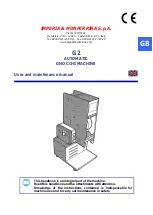
14
2.4 COMMISSIONING AND TESTING
Once all the connections have been made, the appliance and the overall installation must be
checked following the directions given in this manual.
Check in particular:
that the protective film has been removed from the external surfaces;
that connections have been made in accordance with the requirements and directions
indicated in this manual;
that all safety requirements in current standards, statutory regulations and directives have
been met;
that the water and gas connections are leak-free;
that the electrical connection has been performed according to standards.
Now the appliance can be ignited following the instructions for use and controlling the
following points:
progressive ignition of the burner;
even flames;
flame security: check these points at both minimum and maximum output.
Check that the flue gas exhaust is not clogged and that they are expelled without any
hindrance.
The test report must be completed in full and submitted to the customer who should then
sign in acceptance. With effect from this moment, the appliance is covered by the
manufacturer’s warranty.
2.5 CONVERSION TO OTHER GAS TYPES
To convert the appliance for use with another type of gas, the injectors on the main burners
and on the pilot burner need to be replaced. (See Table 5 and figure “Main burner”).
All the injectors needed for the different types of gas are contained in a bag supplied with the
appliance.
The supply pressure and the manual setting of minimum output should also be checked.
(See Table 4 – Minimum output setting).
2.5.1 REPLACEMENT OF MAIN BURNER INJECTORS
The injectors can be reached by removing the lower front panel, once the two side screws
have been unloosed.
Disconnect the tube with the injectors, undo the screws and remove.
Use a fixed wrench SW11 to remove injector and replace it with a suitable one.
Re-install the primary air regulation bracket at the distance “H” as shown in Table 5, see also
“Primary air regulation”.
Summary of Contents for 100LT
Page 21: ...21 4 2 MEASURING INLET PRESSURE A Inlet pressure intake B Outlet pressure intake A B...
Page 23: ...23 4 4 PILOT BURNER A Thermocouple B Pilot burner C Ignition plug D Injector E Tightness screw...
Page 24: ...24 4 5 MAIN BURNER A Burner B Injector C Injector pipe B C A 4 6 PRIMARY AIR REGULATION H...











































